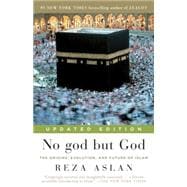
Note: Supplemental materials are not guaranteed with Rental or Used book purchases.
Purchase Benefits
What is included with this book?
| Acknowledgments | p. vii |
| Preface to the Updated Edition | p. xiii |
| Prologue: The Clash of Monotheisms | |
| Author's Note | p. xxvii |
| Chronology of Key Events | p. xxix |
| Maps | p. xxxii |
| The Sanctuary in the Desert | |
| Pre-Islamic Arabia | p. 3 |
| The Keeper of the Keys | |
| Muhammad in Mecca | p. 23 |
| The City of the Prophet | |
| The First Muslims | p. 50 |
| Fight in the Way of God | |
| The Meaning of Jihad | p. 76 |
| The Rightly Guided Ones | |
| The Successors to Muhammad | p. 109 |
| This Religion Is a Science | |
| The Development of Islamic Theology and Law | p. 142 |
| In the Footsteps of Martyrs | |
| From Shi'ism to Knomeinism | p. 174 |
| Stain Your Prayer Rug with Wine | |
| The Sufi Way | p. 199 |
| An Awakening in the East | |
| The Response to Colonialism | p. 225 |
| Slouching Toward Medina | |
| The Quest for Islamic Democracy | p. 255 |
| Welcome to the Islamic Reformation | |
| The Future of Islam | p. 278 |
| Glossary | p. 293 |
| Notes | p. 299 |
| Works Consulted | p. 315 |
| Index | p. 321 |
| Table of Contents provided by Ingram. All Rights Reserved. |
The New copy of this book will include any supplemental materials advertised. Please check the title of the book to determine if it should include any access cards, study guides, lab manuals, CDs, etc.
The Used, Rental and eBook copies of this book are not guaranteed to include any supplemental materials. Typically, only the book itself is included. This is true even if the title states it includes any access cards, study guides, lab manuals, CDs, etc.